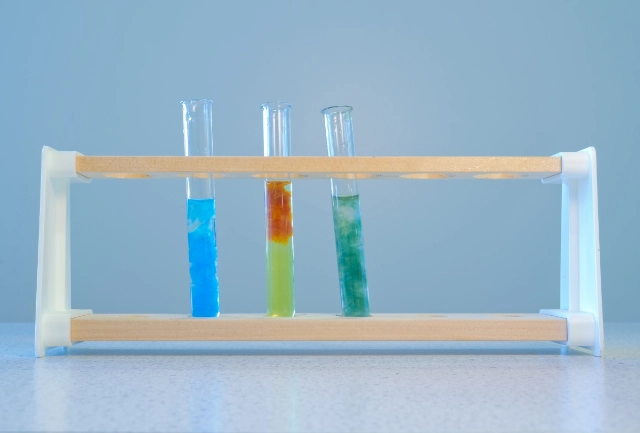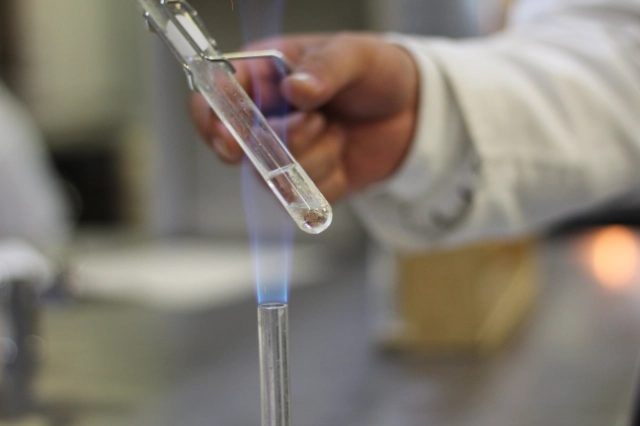Cation tests using sodium hydroxide

Learning outcomes
After studying this page, you should be able to:
- describe how to test for metal ions and ammonium ions, NH4+
- recall the metal hydroxide colours for these ions:
- copper(II), Cu2+
- iron(II), Fe2+
- iron(III), Fe3+
- chromium(III), Cr3+
- aluminium, Al3+
- calcium, Ca2+
- zinc, Zn2+
Testing for ammonium ions
Ammonium ions react with hydroxide ions to produce water and ammonia:
NH4+(aq) + OH–(aq) → H2O(l) + NH3(g)
Ammonia dissolves in water to form an alkaline solution.
These two observations are the basis of the test for ammonium ions. Ammonium salts are soluble in water, so the test works for solid samples as well as aqueous solutions.
Method
If the sample is in the solid state, dissolve a small portion in deionised or distilled water.
- Add 1–2 cm3 of the aqueous sample to a clean test tube.
- Add 1–2 cm3 of dilute aqueous sodium hydroxide.
- Gently warm the mixture using a test-tube holder and a Bunsen burner. Take care not to boil it and point the mouth of the test tube away from people.
- Place the test tube in a test-tube rack. Add a drop of water to a piece of red litmus paper (just enough to dampen it). Hold the damp litmus paper just inside the mouth of the test tube. Record your observations.

Results
Testing for metal ions
Most metal hydroxides are insoluble in water. They appear as precipitates if they form in chemical reactions. For example, when aqueous copper(II) chloride is added to aqueous sodium hydroxide:
copper(II) chloride + sodium hydroxide →
CuCl2(aq) + 2NaOH(aq) →
The insoluble copper(II) hydroxide appears as a light blue precipitate. Different metals form precipitates with different colours.
All sodium, potassium and ammonium salts are soluble. This is why sodium hydroxide, potassium hydroxide and ammonia solution do not form precipitates. Other hydroxides are insoluble (but calcium hydroxide is partially soluble).
Method
If the sample is in the solid state, dissolve a small portion in deionised or distilled water.
- Add about 2 cm3 of the aqueous sample to a clean test tube.
- Add a few drops of dilute aqueous sodium hydroxide. Record your observations.
- Continue to add the sodium hydroxide solution, gently shaking the test tube every so often. Record your observations.
The aim of step 3 is to add excess sodium hydroxide. This is more than enough to produce a precipitate from all the metal ions in solution.
Results
| Metal ion | Colour of precipitate |
|---|---|
| copper(II), Cu2+ | Light blue |
| iron(II), Fe2+ | Green (turns brown after a while) |
| iron(III), Fe3+ | Red-brown |
| chromium(II), Cr3+ | Green, pale green solution in excess NaOH |
| aluminium, Al3+ | White, colourless solution in excess NaOH |
| calcium, Ca2+ | White |
| zinc, Zn2+ | White, colourless solution in excess NaOH |
Iron(II) ions oxidise in air to form iron(III) ions. This is why the green iron(II) precipitate gradually turns red-brown.
Video
The video shows a solution containing copper(II) ions being tested. You can see here what dropwise and excess mean. The blue precipitate does not react with excess sodium hydroxide.
- Flame testing salts of lithium, sodium, potassium, calcium, copper(II) and strontium.
- Flame testing lithium chloride
- Flame testing sodium chloride
- Flame testing potassium chloride
- Flame testing calcium chloride
- Flame testing copper chloride
- Flame testing strontium chloride
- Reaction of calcium carbonate with acid, testing for sulfate ions, and testing for iodide ions.
